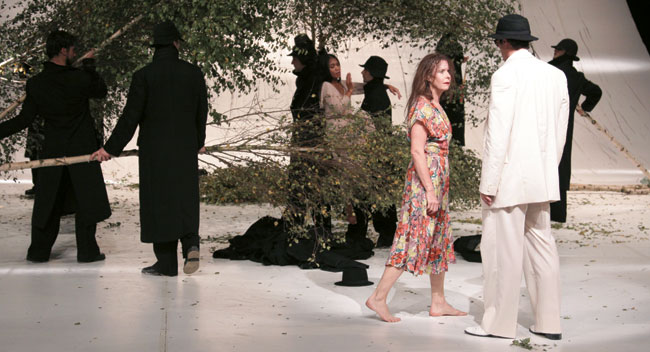
May 20, 2010
Come Dance With Me
Three decades after its debut, Pina Bausch’s seminal work comes to Japan
By Metropolis
Originally published on metropolis.co.jp on May 2010

© エー・アイ 飯島直人
In recent years, the term “dance-theater” has come to mean the glossy pop-ballet productions of English director Matthew Bourne. But when German choreographer Pina Bausch coined the word Tanztheater in 1968, it represented something altogether different.
In Bausch’s formulation, the phrase meant a fusion of the physical expressiveness of dance with the psychological possibilities of theater, embracing movement, language and music in the same structure. During the ’70s, Bausch roiled a dance world in thrall to the abstract beauty of postwar American choreographers like George Balanchine with works of primal fury that portrayed acts of horrific sexual violence.
It is impossible to understate the influence that Bausch has exerted on contemporary dance—particularly in Japan, where Tatsumi Hijikata, founder of the avant-garde butoh style, had also rejected idealized movement for choreography that embraced life in all its messiness. Now, a year after Bausch’s death, one of her seminal works finally gets its Japan debut.
Come Dance With Me, which features scenes of a woman being pawed by a group of men onstage, may seem tame to an audience inured to the likes of exhibitionist/artist Tracy Emin. But when Bausch’s works were first presented in Europe in the ’70s, they were greeted with slammed doors and thrown fruit. In other quarters, the performances were simply panned, with New York’s Village Voice dismissing them as “a crock” and The Washington Post more specifically alluding to a “Teutonic attraction to the powers of darkness, to an alliance of art, disease and malevolence.” Audiences accustomed to Balanchine and Graham were shocked—as were the dancers themselves.
“In one rehearsal, all the men in the company had to do six ways of groping you and kissing you, and it was just like being raped,” Australian dancer Meryl Tankard told The Guardian. “I finally broke down crying.”
The two-hour, one-act Come Dance With Me features 27 dancers, among them longtime Tanztheater member Josephine Ann Endicott, who appeared in the original production. Endicott has rehearsed the current revival tour and knows Bausch’s works perhaps better than anyone, calling theirs “a close love-hate relationship.”
It’s said that European audiences were quicker to accept Bausch’s provocative work than American ones because the psychic trauma caused by World War II was still being felt on the Continent. The parallels to a decimated postwar Japan and butoh are clear—although whether this sort of work continues to resonate with a younger audience that has no such experience and little historical memory remains open to question.
Come Dance with Me
Ballet piece by the late great German choreographer Pina Bausch, performed to commemorate her death last June. June 8-11, 7pm; June 12 & 13, 2pm, ¥5,000 (D)/¥7,000 (C)/¥9,000 (B)/¥11,000 (A)/¥13,000 (S). Shinjuku Bunka Center. Tel: 03-3350-1141.







